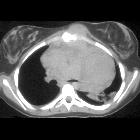Morbus Hodgkin




















Hodgkin lymphoma or Hodgkin disease (HD) is a type of lymphoma and accounts for ~1% of all cancers. Hodgkin disease spreads contiguously and predictably along lymphatic pathways and is curable in ~90% of cases, depending on its stage and sub-type.
Epidemiology
There is a bimodal distribution in the age of affected patients, with peaks in young adults (15-34 years) and older patients (>55 years).
Clinical presentation
Typical presentation is with painless lymphadenopathy. Systemic symptoms (B symptoms) such as night sweats and weight loss may be present.
An uncommon presentation described in Hodgkin disease is pain in involved organs following alcohol consumption.
Pathology
The disease is characterized by the presence of Reed-Sternberg cells (considered to be a type of B cell). These cells however only occupy a very small proportion (<5%) of the overall cell population of the affected lymph node. Contiguous spread is another feature. EBV infection is present in 40-80% depending on subtype .
Subtypes
There are five recognized histological subtypes, subdivided into two groups, classical and non-classical.
Classical
Positive for CD15/CD30 and negative for CD20/CD45/EMA:
- nodular sclerosing: ≈70%
- mixed cellularity: ≈25%
- lymphocyte-rich: 5%
- lymphocyte depleted: <5%
Non-classical
Positive for CD 19, 20, 22, 79a/EMA and negative for CD15/CD30:
- nodular lymphocyte predominant (nodular paragranuloma)
Classification
For classification of lymphomas see WHO classification of neoplasms of lymphoid tissues.
Location
Nodal disease
Hodgkin disease is usually almost entirely confined to the lymph nodes. It typically starts in the upper body (neck, armpits, chest).
Extranodal disease
Extranodal Hodgkin disease although uncommon may be found in any organ system, either as a primary manifestation or as dissemination of systemic disease. This distinction is important, as disseminated disease carries a poorer prognosis. Extranodal disease may occur via invasion of adjacent tissue or via haematogenous spread.
Organ-specific involvement:
- pulmonary manifestations of Hodgkin lymphoma
- cardiac manifestations of Hodgkin lymphoma
- musculoskeletal manifestations of Hodgkin lymphoma
- abdominal manifestations of Hodgkin lymphoma
- CNS manifestations of Hodgkin lymphoma
Staging
In contrast to other types of lymphoma, Hodgkin disease is usually characterized by a systematic nodal spread pattern making accurate staging important.
See main article: Hodgkin lymphoma staging.
Treatment and prognosis
Prognosis depends on stage as well as several other factors such as age, serological markers (ESR), presence of B symptoms, and histological tumor subtype:
- nodular lymphocyte-predominant: best prognosis
- lymphocyte depleted: worse prognosis
Treatment is dependent on the stage of the disease:
- stage IIa and below: localized radiotherapy
- stage IIb and above: chemotherapy +/- radiotherapy to sites of large tumor bulk
See also
Siehe auch:
und weiter:
- Lymphom
- Tumoren des vorderen oberen Mediastinums
- mediastinal lymphoma
- cancer
- Thymuslipom
- bilaterale hiläre Lymphadenopathie
- Lymphom der Mamma
- WHO classification of neoplastic diseases of lymphoid tissues
- AIDS defining malignancies
- pulmonary manifestations of Hodgkin lymphoma
- malignancies in childhood
- mediastinal Hodgkin's lymphoma
- meningeale Beteiligung bei Morbus Hodgkin
- hodgkin lymphoma staging
- nodulär sklerosierender Typ des Hodgkin-Lymphoms
- Lymphom der Dura
- Morbus Hodgkin der Niere
- Morbus Hodgkin PET-CT
- Meningeosis lymphomatosa
- Hodgkin-Lymphom des Knochens

 Assoziationen und Differentialdiagnosen zu Morbus Hodgkin:
Assoziationen und Differentialdiagnosen zu Morbus Hodgkin:
